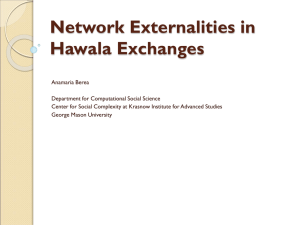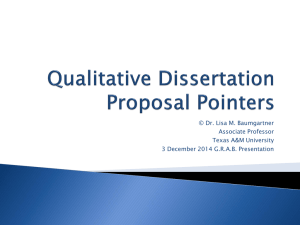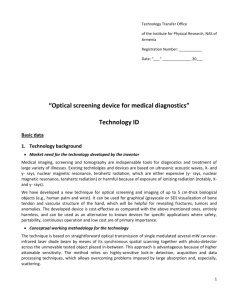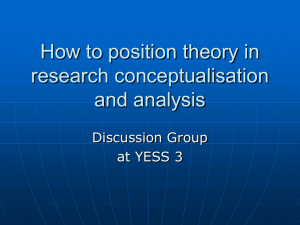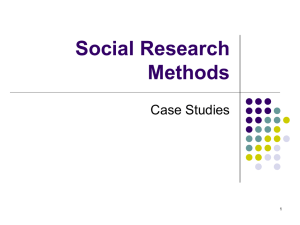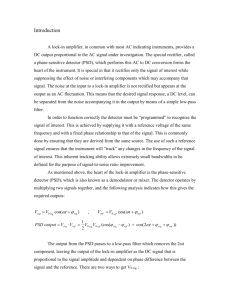View this presentation
advertisement
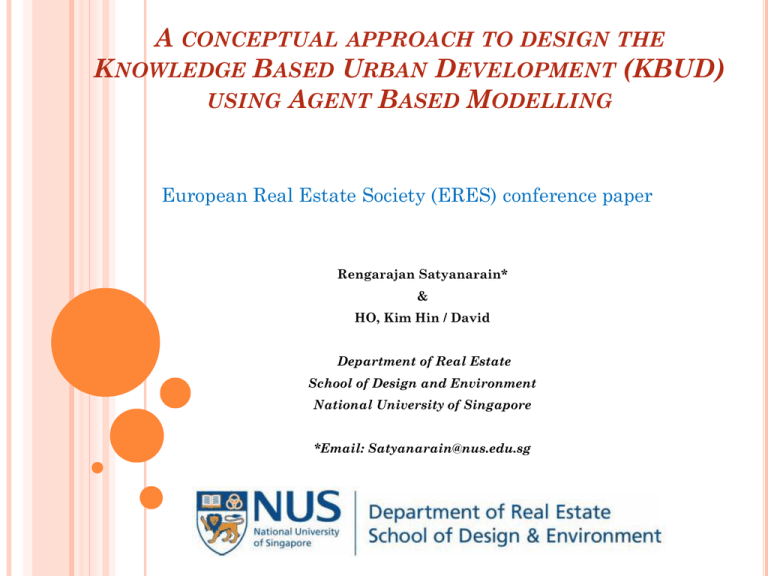
A CONCEPTUAL APPROACH TO DESIGN THE
KNOWLEDGE BASED URBAN DEVELOPMENT (KBUD)
USING AGENT BASED MODELLING
European Real Estate Society (ERES) conference paper
Rengarajan Satyanarain*
&
HO, Kim Hin / David
Department of Real Estate
School of Design and Environment
National University of Singapore
*Email: Satyanarain@nus.edu.sg
Introduction: what are knowledge based urban developments?
Contents of the paper
We look at how to design (land use planning) a Knowledge
Based Urban Development (KBUD) so as to enhance intracluster knowledge interactions.
Research Implication
Develop physical planning guidelines which would help urban
planners create effective zoning (mixed-use) policies.
Background : Influence of design on knowledge based work
Knowledge catalysing the process of technological
innovation is undisputed in the Science and Technology
(S&T) literature.
Sources: Hargadon & Sutton, 1997; Kanter, 1988; I
Nonaka & Konno, 1998
Individuals working in knowledge intensive industries
require information resources [Medium of access]
E.g. Face-to-Face, Journal articles and other forms of
media (television, internet, newspapers etc.)
Face-to-face (F2F contact )
Sources: Allen (1984) ; Ancona,1990 ;Ancona and
Caldwell’s ,1992; Audretsch & Feldman, 1996 ;
Feldman, 2000; Storper & Venables, 2004 ;
Interaction with peersF2F
Productive/innovative
Background: Workspace design / Urban scale designs
Workspace planning /design studies for knowledge
based environments
Space syntax Analysis: Exploit differences in spatial
layouts, circulation systems, visibility, adjacencies, mean
integration etc to maximize the probability of interaction.
Scale : Building
Sources : Backhouse & Drew, 1992; F Duffy, 1997; Penn,
Desyllas, & Vaughan, 1999; Peponis et al., 2007; Serrato
& Wîneman, 1999).
Urban planning/design studies for knowledge based
environments
There are almost no studies looking at how to design
interactive environments on an urban scale as required for
KBUD.
Scale : Precinct
3.
Research problem
Designs have been Ad-hoc and experimental.
Euclidian (single land use)
Mixed use zoning
vs.
A mixed use design should promote “knowledge” interactions (planned and
spontaneous)
This is achieved through complimentary zoning
Premise: some actors have higher chances of interaction than others.
3.
The research question
What is the urban design criteria of the
knowledge based urban development ?
Knowledge
interactions
Social
Environmental
Economic
Transportation
Knowledge/information interactions
What are knowledge interactions?
“the continuous and dynamic interaction between tacit and explicit
knowledge that happens at the individual, group ,institutional,
organizational,
and
inter-organizational
levels
that
leads
to
creation/sharing or transfer of knowledge”
- Nonaka & Takeuchi
(1995).
Source: Alan frost (2003); Adapted from classification given by Asheim and Gertler, (2005)
Knowledge/information interactions
Intra-cluster
interactions
Knowledge bases
Source: Alan frost (2003); Adapted from classification given by Asheim and Gertler, (2005)
Literature review – Current design practices
General rule of mixed land use designs for KBUD’s
I.
Diversity
II.
Triple helix model of Innovation . (Leydesdorff & Etzkowitz ,1998).
Geographical proximity
“short distances literally bring people together, favour information contacts and
facilitate the exchange of tacit knowledge. The larger the distance between agents, the
less the intensity of these positive externalities, and the more difficult it becomes to
transfer tacit knowledge”
-Boschma, 2005
Interactive design = “Accommodate a diverse set of actors into a small area of
land”
Literature review – Current design practices
DMC Seoul KBUD design
a “futuristic info-media industrial complex”, has planned for a city street
which is to host “entertainment and retail establishments, technology
companies, prestige housing, R&D institutions, and universities”.
The same street supposedly would host leisure activities such as
“theatres, cafés, stores, nightclubs and LCD screens as big as whole
buildings”.
Source: http://sap.mit.edu/resources/portfolio/seoul/
Literature review - Knowledge interaction determinants
Spatial proximity maybe necessary
Mixed land
uses
Not sufficient
Other dimensions of proximity ..
Literature review - Knowledge interaction determinants
Proximity
factors
Institution
Key
dimension
Organizational
Trust (based on
common
institutions)
Control
Knowledge base
Base gap
Cognitive base
Knowledge gap
Geographical
Distance
Proximity
Too little
Too high
Opportunism
Lock-in
Network disruption
Bureaucracy
Lack of common
base
Physical barrier for
fertilisation
Misunderstanding
Unintended spillovers
An optimal mix of agents on these terms can
facilitate reduced physical barriers to
knowledge interaction
Source: Boschma (2005)
Theoretical criteria of a knowledge interactive urban design
Interaction
level (I)
0
Lock-in
Proximity
Knowledge base
Institutional
Organizational
Cognitive
1
Lock-in
A simple 2-Dimensional Illustration of ‘lock-in’ design effect
A
E.g. Illustration of Design
“lock-in effects”
in a KBUD
A) “Institutional lock-in”
B) “Cognitive lock-in”
B
*Illustrative purpose only
3.
Methodology
Theoretical Model of design
‘Optimal’ design =(Design criteria, Spatial constraints, Actors [Number &
Distribution] )
Theoretical model of design
(AGM)
Design
3.
Methodology- Land use design models in planning
Urban Planning
literature
Land use design optimization problems
Single objective
Multiple
objective
Single land use model: Meier,(1968)
Multiple land use: Correia and
Madden,(1985); Davis and grant,(1987)
Multiple land use : Kenneth (1965)
;Barber (1976); Arad and Berechman (1978);
Williams and Revelle (1996); Makowski
(1997); Janssen et al (2008);
Regular grid (non-overlapping)
No explicit representation of space
Multiple objective
Spatially explicit
Multiple land use
Overlapping
Linear
Programming
methodology
Methodology- Agent based modeling
Typical Land use design model (MAS)
Decision
function
Selfselect
Agents
criteria
zones
S
Unsatisfied
constraint
s
1
Physical definition (conceptual/real)
2
Actor classification
3
Constraints (limits of the system)
4
Operational objective functions (evaluation)
Source:Ligtenberg et al, (2004)
Actors in the KBUD
Agents
Firm (high tech, service, business etc.)
University department (i)
Public research institute (PRI)
Private institute (PVRI)
Misc (Retail, commercial, housing etc)
Classification
J= Institution
K=Organization
L =Knowledge base (Asheim et al,2007)
M= Cognitive field
Agents
Size 100-500 hectares
Embedded
j
k
l
m
Theoretical model of design
Land use
design
Quantity variables
Quality variables
Location variables
Space constraints
Types of land uses
Zonal interaction
Source: Adapted from Kenneth
Schlager,1965
Where,
Theoretical model of design
Quality
variable
Quantity
variables
Optimal design algorithm
Agent rules
Start
Define space [e.g. plot ratio, parcel size, road length etc]
Initiate agents (AIP). Occupy random position in space.
Minimize the mean distance between ‘related’ agents. [KI – Design criteria]
Upon reaching equilibrium, locate to the nearest available block.
If KI is unsatisfied, re-define space and repeat step 2.
If KI is satisfied. Initiate subsidiary agents (i.e. service ratio requirements).
End
Agent base land use model (AGB-LUM)’s architecture
1.
2.
3.
Spatial constraints
Plot ratio
Land parcels (no.)
Minimum requirements (setbacks,
accessory etc in sq m)
Economic forecasts
AIP
Agents
KI criteria
KBUD system
Design Type
Subsidiary land use
I) Planning ratios
1.
2.
3.
4.
Knowledge bases
Institutional
Organizational
Cognitive
Future work
Case study :One north KBUD system
Data
1.
2.
3.
4.
Land use plans
Planning ratios
Plot ratio, Set backs etc
Land use designs
Source: JTC
Phase 1 & 2-Biopolis-Land use distribution (by organization)
Organizational composition
Research institution
Technology firm
University (learning)
misc
Model output
Input data
1) Agent Identification
2) Coordinate map
3) Rules
4) Planning ratio ( i.e.
minimum requirements)
Output data
1)Land use composition
2)Plot Ratios
3) Subsidiary land uses
4) Zonal maps (2-D)
3.
Research Contribution
Agent based
modeling
literature
Land use design
models in planning
KBUD
Literature
Linear programming
Knowledge interaction criteria (KIC)
KBUD
Theoretical model of
urban design
(Our contribution)
Planning practice
Governance ,
Institutional planning
models ,
Planning metrics
Urban design
1
Have not paid attention to the role of urban design in KBUD literature
2
No theoretical basis on how to effectively mix land uses .
3
Previous urban design models have predominantly used linear programming
methodology (LPM).
Conclusion
Our paper addresses the issue of urban design for knowledge based
urban development.
Urban designs emphasizing spatial proximity (density) and diversity
alone may not favor interactive environments.
Propose a theoretical framework for a design tool using ABM
approach.
The End
Thank you for listening
Q&A
Case study :One north KBUD system
Data
1.
2.
3.
4.
Land use plans
Planning ratios
Plot ratio, Set backs
etc
Land use designs
Source: JTC
Design Parameter assumptions
Agents
Assumptions
Technology Firm
Unit of occupation: Firm
Minimum number of persons/firm: 20
Space per person: 70 sq ft
Space per firm: 1500 sq ft
Research institution
Unit of occupation: Department/firm
Minimum number of persons department/firm: 20
Space per person: 70 sq ft
Space per Department: 1500 sq ft
Unit of occupation: Department
MnoD : 10 departments
Space per department: 2000 sq ft
Unit of occupation: Firm
(Mno)persons/firm: 20
Space per person: 50 sq ft
Space per firm: 2000 sq ft
Educational
(university)
Service firm
Sub-Agents
Subsidiary land use specifications
Green space
Regional ratio of 6 sq m per person (entire development)
Retail
3 sq m per person
Housing
80 sq m per person
Recreational
3 sq m per person
Source: Authors,2013 & One north masterplan (2008)
Model output
Input data
1) Agent Identification
2) Coordinate map
3) Rules
4) Planning ratio ( i.e.
minimum requirements)
Output data
1)Land use composition
2)Plot Ratios
3) Subsidiary land uses
4) Zonal maps (2-D)
Theoretical model of design
ONE NORTH-BIOPOLIS BASELINE (AIP)
Type
Percentage
Space needed (GFA) in
Sq ft.
Characteristics
48%
285,600
Research institution/firms
40%
130,400
Housing
Work
Live
Representative
unit
Agents
Dept./firm
285
Apartment unit
Learn
D
Department
9%
38,250
Educational [university,
school etc]
Play
D
N.A
3%
Total
122(meters)
41250.64 [meters]
100%
Source: One north masterplan,2008
Green space (80 %)
Sports & recreation (20%)
D
Theoretical model of design
BASELINE SCENARIO -2-DIMENSIONAL
Knowledge base Composition-Analytical (Biomedical sci
Retail
Research Instituti
Housing
Green space
Screenshots
Phase 1 & 2-Biopolis-Land use distribution
Total population
Knowledge base Composition
Phase 1 & 2-Biopolis-Land use distribution (by instituition)
Land use design –Institutional base
Institutional Composition
Subsidiary land uses
Phase 1 & 2-Biopolis-Land use distribution (by organization)
Organizational composition
Research institution
Technology firm
University (learning)
misc
Fully populated model by institutional-Sample design
Design Type
Knowledge base –
High
Institutional-High
Public
Private
Model output
Input data
1) Agent Identification
2) Coordinate map
3) Rules
4) Planning ratio ( i.e.
minimum requirements)
Output data
1)Land use composition
2)Plot Ratios
3) Subsidiary land uses
4) Zonal maps (2-D)
Summary of the paper
The paper provides a theoretical criteria to help design KBUD.
Proposes an new methodology (AGM) to aid land use planning.
Towards a more scientific and dynamic approach in designing mixed use
developments.
A flexible approach reduces reliance on long term designs.
The ‘Lock-in’ design phenomenon
Institutional ‘Lock-in’
Knowledge base ‘Lock-in’
Organizational ‘Lock-in’
Why is it important?
Design goals (criteria) are important for physical planning to take
shape over time.
Effective zoning can help actors share resources efficiently.
It can prevent land use conflicts arising from different actors.
E.g. Housing Estates
•Reduce commuting costs
•Make amenities accessible by walk
,parks,retail etc.)
•Social goals
community
less pollution.
Schools
fostering sense of
3.
Research problem 2 : The design process
Actori
(T0,Tn
)
Urban design
criteria
i є [ University, public, private research institutes,
firms, service companies etc]
Defined land area divided
into a set of N
land parcels
KI
Urban design
1
2
3
Uncertainty of participants
Static urban designs
Design Criteria for knowledge interaction
Zoning guidelines
Spatial
Constraints
{a,b…z} є N
